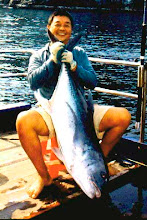Comparatively, the Indo-Pacific tarpons, or the ox-eye (Megalops cyprinodes) are very much smaller. Most are around 1 to 2 feet long and weight of a kilo is already considered good. Maximum weight of about 18kg have been recorded, but this bigger size one can only be found in the open sea.
The ox-eyes can be found along the tropical coastal regions of Eastern Africa, South East Asia, Japan, Tahiti and Australia. The ox-eyes look exactly like the Atlantic tarpons with olives green colour on top and silver on the side. The large mouths are turned upwards, and the jaws are quite hard and bony. Having the distinctive elongated last dorsal ray reaching to almost the tail, this fish is beautiful.They normally spawn at sea and the young larvae migrate inland to brackish water.
Fly-fishing for them can be very effective though tying small jigs, spinners and tiny spoons can catch fish too. When caught they are real acrobatic fighters.
 |
| This was taken on fly (shrimp fly). Behind me can be seen rises denoting the presence of tarpons. |
 |
| This irrigation canal is a good hunting ground for tarpons. |
 |
| A small specimen which is the common size in brackish water. Bigger fishes can be found in the open sea. |
 |
| Fly-fishing is very effective for the tarpons. But they can be taken on small jigs, spinners and spoons too. |
 |
| Normally, canals leading to some river mouths near the sea will contain good population of these tarpons. |
